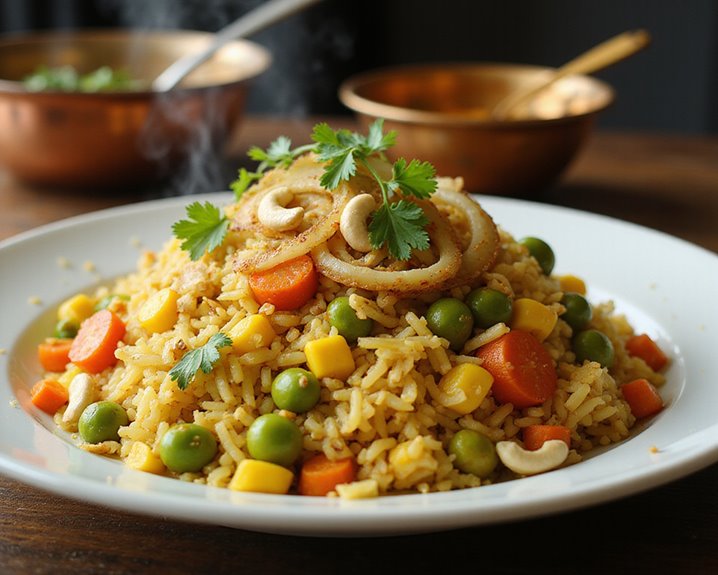Why You’ll Love this Indian Biryani
Although biryani might seem intimidating at first glance, this recipe takes all the guesswork out of creating this beloved Indian dish. I’ve simplified the process while maintaining all those incredible flavors that make biryani so special.
You’ll adore how the fragrant basmati rice absorbs the aromatic spices, creating layers of flavor with each bite. The combination of mint, cilantro, and homemade masala paste delivers that authentic taste without requiring a spice cabinet overhaul. Can you imagine the look on your guests’ faces when you bring this colorful dish to the table?
The beauty of this recipe? Its flexibility. Those frozen veggies make prep work minimal, while the yogurt secures a creamy texture that balances the warming spices perfectly. Weeknight-friendly but impressive enough for company.
What Ingredients are in Indian Biryani?
Indian biryani is a fragrant, flavorful rice dish that combines aromatic spices, tender meat or vegetables, and perfectly cooked basmati rice. The ingredients list might seem lengthy at first glance, but don’t let that intimidate you. Each component plays an indispensable role in creating that authentic biryani experience that’ll transport your taste buds straight to the streets of Mumbai or Delhi.
- 1½ cups basmati rice, cooked
- ½ cup Ragu tomato sauce
- ½ cup yogurt
- 1 onion, chopped
- 1 onion, thinly sliced lengthwise and fried until brown
- 7 cashews
- ½ teaspoon cumin seeds
- 2 teaspoons biryani masala
- 1 teaspoon ginger-garlic paste
- ½ teaspoon chili powder
- ½ teaspoon cumin coriander powder
- ¼ teaspoon garam masala
- 2 cups frozen vegetables (corn, carrots, peas and beans)
- ½ cup fresh mint
- ½ cup fresh cilantro leaves
- 3 teaspoons leftover green chutney
- 2 teaspoons ghee
The quality of your ingredients can make or break your biryani. Aged basmati rice will give you the best texture and aroma. Can’t find biryani masala? You can substitute with a blend of common Indian spices like cardamom, clove, and cinnamon. The fried onions (sometimes called birista) aren’t just a garnish—they add a vital sweet, caramelized flavor that’s characteristic of traditional biryani. And while this recipe uses frozen vegetables, feel free to swap in chicken, lamb, or paneer for a protein-packed version.
How to Make this Indian Biryani

To start this flavorful biryani journey, heat half of your 2 teaspoons of ghee in a pan. When it’s nice and hot, add the 1/2 teaspoon of cumin seeds and let them dance around until they begin to sizzle and release their earthy aroma. Toss in your chopped onion and let it cook for about a minute until it softens slightly.
Now comes the flavor explosion—add 1 teaspoon of ginger-garlic paste, 7 cashews, 1/2 cup Ragu tomato sauce, 1/2 cup of fresh mint, 3 teaspoons of leftover green chutney, 1/2 cup yogurt, and all those wonderful spices (2 teaspoons biryani masala, 1/2 teaspoon chili powder, 1/2 teaspoon cumin coriander powder). Let this mixture cook for about 4 minutes, and your kitchen will fill with the most intoxicating aroma. Who needs scented candles when you’ve got biryani cooking, right?
Once your spice mixture has developed its flavors, transfer it to a blender and blend until smooth. This creates the rich, aromatic paste that gives biryani its signature taste. In a fresh pan, heat the remaining ghee and add your blended paste. This is where patience pays off—cook the paste until the oil begins to separate and rise to the surface. At this point, you’ll add your 2 cups of frozen vegetables (those colorful corns, carrots, peas, and beans) and gently fold in the 1 1/2 cups of cooked basmati rice. For more authentic flavor and preparation, consider using specialized Indian spice appliances designed specifically for grinding fresh spices and preparing complex masalas.
The final touch? A sprinkle of 1/4 teaspoon garam masala and a garnish of those beautifully fried, thinly sliced onions and fresh cilantro leaves. The layering of flavors in this dish is what makes it so special—each bite offers something slightly different yet harmonious.
Indian Biryani Substitutions and Variations
Three wonderful aspects of biryani make it one of the most adaptable dishes in Indian cuisine—its forgiving nature, regional diversity, and personal expression. I can’t think of another dish that welcomes substitutions so graciously.
Don’t have basmati? Jasmine rice works in a pinch. No garam masala? A mix of cinnamon, cardamom, and cloves will do. Vegetarians can skip meat entirely and double up on vegetables or add paneer. The frozen veggie mix can be replaced with whatever’s fresh in your fridge.
Regional variations abound—Hyderabadi biryani features more chilies, while Lucknowi style is milder and more aromatic. You might prefer it saucier (add more yogurt) or drier (reduce liquid). The beauty lies in making it yours.
What to Serve with Indian Biryani
Although biryani stands proudly as a complete meal on its own, pairing it with complementary sides elevates the dining experience to something truly special. I’m all about creating that perfect balance of flavors and textures when serving this aromatic rice dish.
Raita is my go-to companion—this cooling yogurt condiment helps temper the spiciness while adding creamy contrast. A crisp cucumber salad with lemon dressing offers invigorating brightness. Want something more substantial? Try serving papadums (those delightfully thin, crispy lentil wafers) or naan bread for scooping up every last grain.
For drinks, nothing beats a mango lassi or traditional masala chai. These beverages provide the perfect counterpoint to biryani’s bold flavors. Isn’t it amazing how the right sides can transform an already fantastic dish?
Final Thoughts
While mastering this Indian biryani might seem formidable at first, I’m convinced anyone can create this spectacular dish with a bit of patience and the right ingredients. The aromatic blend of spices, tender vegetables, and fluffy basmati rice creates a symphony of flavors that’s truly worth the effort.
Remember, biryani isn’t just food—it’s a celebration on a plate. Don’t stress about perfection; each batch becomes better than the last. The beauty lies in making it your own. Add more chili if you like it spicy, or toss in extra cashews for crunch.
What makes biryani special? Perhaps it’s how it brings people together, creating moments of joy around the table. So gather your ingredients, embrace the process, and enjoy the delicious results.

